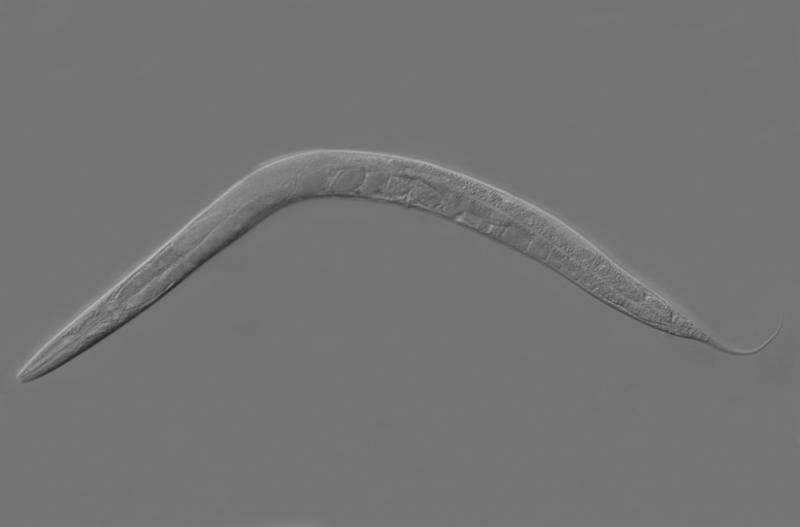What a tiny, wiggling worm can teach us about cancer

One would think a transparent, tiny—about one millimeter in length—organism could have difficulty catching anyone's attention. The roundworm Caenorhabditis elegans (C. elegans), however, has been in the biological research spotlight for decades. Scientists first proposed the worm as a model for studying development biology and neurobiology in the 1960s. In 1998, C. elegans became the first animal to have its genome fully sequenced and even today hundreds of labs dedicate time and resources to find out more about the worm and how it can help us answer some of biology's fundamental questions.
How does a single cell become a multicellular organism? What are the genes that control cell division and cell movement? Ian Chin-Sang, a developmental biologist, has dedicated his career to asking these and similar questions. In his lab in the Department of Biology at Queen's, he combines genetics, molecular biology, biochemistry, and video microscopy techniques to study C. elegans and understand how animals—including humans—develop.
C. elegans and humans share about 40% of the same genetic makeup—meaning that 40% of human genes are homologous, or similar in structure, with the worm's DNA. On the other hand, roundworms are much simpler organisms, with only about 1,000 cells, and their transparent bodies make it easy to observe them in detail, even at the single cell level.
Over the past few years Dr. Chin-Sang and his team have been studying C. elegans to investigate cancer genes—the ones that can promote cell division in tumors and metastasis. They have also been investigating the tumor suppressor genes that prevent cells from multiplying. Mutations and genetic predispositions that block tumor suppressor genes can lead to cancer.
"We study how the worm develops and apply this knowledge to understanding what goes wrong during cell division that causes cancer," Dr. Chin-Sang explains. "We are also interested in the mechanisms behind how tumor cells invade surrounding tissues and move to other locations, creating new tumors. If we can block this mechanism, we can prevent metastasis."
Roundworms do not develop cancer like humans. But they do have tumor suppressor genes and are a good model for understanding what happens exactly when these genes are knocked out. In the worms, like in humans, mutations in a tumor suppressor gene can lead to inappropriate cell division and movement, leading to premature death.
Dr. Chin-Sang's team is particularly interested in the worm's genetic correspondent of PTEN, a gene whose loss is involved in around 70% of prostate cancers, and other types of tumors. Although humans and roundworms have obvious differences, what happens inside the cells of each organism is comparable.
"We think of the cell as a molecular machine that needs to function properly. What happens if you alter the components of the machine? That's what we mockup in the lab. How that machine works in the worm is likely the same as it does in human cells," Dr. Chin-Sang says.
Scientists can manipulate C. elegans' genes in all sorts of ways. Also, researchers can use the worm to test drug candidates and see if they are effective in slowing cell division or cell movement. These experiments can eventually guide scientists on which substances to test in more complex biological models, and eventually in humans.
Current programs
In addition to studying cell division and its connections to cancer, Dr. Chin-Sang's team is investigating the cellular insulin signaling pathway. While insulin is mostly known for regulating blood glucose levels, exacerbated insulin signaling can lead to tumor development. Although C. elegans do not produce insulin, they do have insulin-like molecules, and the molecular machinery that regulates these is very similar to the insulin signaling pathway found in human cells. Also, the worm has genes that can block such signaling, providing insights on what happens to humans.
"This could be very important for designing new drugs," Dr. Chin-Sang says. This research program is funded by the Canadian Institutes of Health Research (CIHR).
Another ongoing program is funded by the Natural Sciences and Engineering Research Council of Canada (NSERC) and aims to clarify how embryonic cells change their shape and move to fold up into three dimensional forms. This process is called "morphogenesis" and it is an important aspect of development as it is necessary for giving organs and tissues their three-dimensional shapes. The team is working to identify and characterize genes and proteins that regulate this process.
As a developmental biologist, Dr. Chin-Sang strives to answer fundamental science questions, and is not always certain, especially in the first stages of a research project, of the possible applications of the knowledge that is being built. But being open to the unexpected pays off—who would think a tiny roundworm could teach us so much about our own health?



















